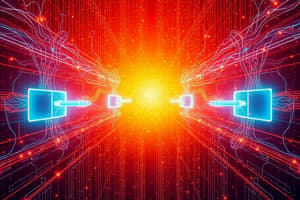Podcast
Questions and Answers
What is the purpose of the BID in a BPDU frame?
What is the purpose of the BID in a BPDU frame?
- To configure the desired root bridge switch
- To elect the spanning tree instance
- To determine the root path cost
- To identify the sending switch and the root bridge (correct)
What happens when two or more switches have the same priority?
What happens when two or more switches have the same priority?
- The switch with the highest MAC address becomes the root bridge
- The switch with the lowest MAC address becomes the root bridge (correct)
- A new spanning tree instance is created
- The default BID is changed to a lower value
What is the primary purpose of STP?
What is the primary purpose of STP?
- To increase link saturation in switched networks
- To prevent Layer 2 loops in Ethernet networks (correct)
- To reduce IPv4 packet retransmission
- To enhance IPv6 packet processing
What is the default BID value?
What is the default BID value?
What happens to a Layer 3 packet when the TTL or Hop Limit field reaches zero?
What happens to a Layer 3 packet when the TTL or Hop Limit field reaches zero?
What is the purpose of the Root ID in a BPDU frame?
What is the purpose of the Root ID in a BPDU frame?
What is the result of a Layer 2 loop in an Ethernet network?
What is the result of a Layer 2 loop in an Ethernet network?
Why is it important to configure the desired root bridge with a lower priority?
Why is it important to configure the desired root bridge with a lower priority?
What happens after the root bridge is elected?
What happens after the root bridge is elected?
What is the purpose of the TTL or Hop Limit field in IPv4 and IPv6 packets?
What is the purpose of the TTL or Hop Limit field in IPv4 and IPv6 packets?
What is the value of the extended system ID associated with each switch?
What is the value of the extended system ID associated with each switch?
What type of frame is forwarded out all ports, except the ingress port, by a switch?
What type of frame is forwarded out all ports, except the ingress port, by a switch?
What is the purpose of the STA?
What is the purpose of the STA?
What is the result of a switch's MAC address table constantly changing?
What is the result of a switch's MAC address table constantly changing?
What happens when a Layer 2 loop occurs in an Ethernet network without STP?
What happens when a Layer 2 loop occurs in an Ethernet network without STP?
Why is path redundancy important in Ethernet networks?
Why is path redundancy important in Ethernet networks?
What is the correct term to refer to the original implementation of spanning tree?
What is the correct term to refer to the original implementation of spanning tree?
What is the version of spanning tree specified in IEEE-802.1D-2004?
What is the version of spanning tree specified in IEEE-802.1D-2004?
What is the default spanning tree protocol used in Cisco switches running IOS 15.0 or later?
What is the default spanning tree protocol used in Cisco switches running IOS 15.0 or later?
What is the term used to describe the assumption made by STP?
What is the term used to describe the assumption made by STP?
What is the main difference between STP and RSTP?
What is the main difference between STP and RSTP?
What must be done to run the rapid spanning tree protocol on a switch?
What must be done to run the rapid spanning tree protocol on a switch?
What is the name given to the original IEEE 802.1D version of spanning tree?
What is the name given to the original IEEE 802.1D version of spanning tree?
What is the purpose of spanning tree protocols?
What is the purpose of spanning tree protocols?
What determines the preferred path in STP operations?
What determines the preferred path in STP operations?
What happens to all other redundant paths in STP operations?
What happens to all other redundant paths in STP operations?
What is the role of a designated port in STP operations?
What is the role of a designated port in STP operations?
What happens to a port that is not a root port or a designated port?
What happens to a port that is not a root port or a designated port?
What is the purpose of alternate ports in STP operations?
What is the purpose of alternate ports in STP operations?
Which ports on the root bridge are designated ports?
Which ports on the root bridge are designated ports?
What is the state of an alternate port?
What is the state of an alternate port?
What is the result of having a loop in the network?
What is the result of having a loop in the network?
What is the primary purpose of Spanning Tree Protocol (STP) in a Layer 2 network?
What is the primary purpose of Spanning Tree Protocol (STP) in a Layer 2 network?
What is the result of redundant paths in a switched Ethernet network?
What is the result of redundant paths in a switched Ethernet network?
What happens when a loop occurs in an Ethernet LAN?
What happens when a loop occurs in an Ethernet LAN?
What is the purpose of redundant networks in a hierarchical design?
What is the purpose of redundant networks in a hierarchical design?
How does STP respond to a failure in the network?
How does STP respond to a failure in the network?
What is the benefit of having alternate physical paths for data to traverse the network?
What is the benefit of having alternate physical paths for data to traverse the network?
What is the role of logical redundancy in a hierarchical design?
What is the role of logical redundancy in a hierarchical design?
What is required in an Ethernet LAN?
What is required in an Ethernet LAN?
Flashcards are hidden until you start studying
Study Notes
Purpose of STP
- Redundancy in Layer 2 networks is essential for eliminating single points of failure and preventing disruption of network services to users.
- Physical redundancy requires the addition of physical paths, and logical redundancy must also be part of the design.
- Redundant paths in a switched Ethernet network can cause both physical and logical Layer 2 loops.
- Ethernet LANs require a loop-free topology with a single path between any two devices.
Spanning Tree Protocol
- Spanning Tree Protocol (STP) is a loop-prevention network protocol that allows for redundancy while creating a loop-free Layer 2 topology.
- STP logically blocks physical loops in a Layer 2 network, preventing frames from circling the network forever.
STP Recalculation
- STP compensates for a failure in the network by recalculating and opening up previously blocked ports.
Issues with Redundant Switch Links
- Path redundancy provides multiple network services by eliminating the possibility of a single point of failure.
- A Layer 2 loop can result in MAC address table instability, link saturation, and high CPU utilization on switches and end-devices, making the network unusable.
Layer 2 Loops
- Without STP enabled, Layer 2 loops can form, causing broadcast, multicast, and unknown unicast frames to loop endlessly.
- This can bring down a network quickly.
- When a loop occurs, the MAC address table on a switch will constantly change with the updates from the broadcast frames, resulting in MAC database instability.
STP Operations
- STP was developed specifically as a loop prevention mechanism for Layer 2 Ethernet.
- The switch with the lowest BID will become the root bridge.
- The administrator should configure the desired root bridge switch with a lower priority.
- The switch with the lowest hexadecimal MAC address value is the preferred root bridge.
- Paths with the lowest cost become preferred, and all other redundant paths are blocked.
- The designated port is a port on the segment that has the internal root path cost to the root bridge.
- If a port is not a root port or a designated port, then it becomes an alternate (or backup) port.
Evolution of STP
- STP has been superseded by the Rapid Spanning Tree Protocol (RSTP).
- The IEEE uses "STP" to refer to the original implementation of spanning tree and "RSTP" to describe the version of spanning tree specified in IEEE-802.1D-2004.
- Cisco switches running IOS 15.0 or later, run PVST+ by default, which incorporates many of the specifications of IEEE 802.1D-2004.
- Switches must be explicitly configured for rapid spanning tree mode in order to run the rapid spanning tree protocol.
Studying That Suits You
Use AI to generate personalized quizzes and flashcards to suit your learning preferences.




